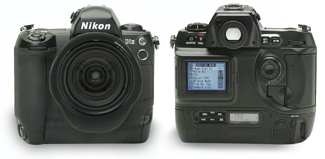The Nikon D1x: An Exceptional Digital Camera for Pros

Imagine a professional SLR (single lens reflex) digital camera that generates smooth, artifact-free color images, 11×16-inch prints (or larger at 240 ppi) and full-page or crossover color separations for magazines.
It’s also affordable – at least for those serious about photography and digital cameras.
I tested such a digital camera for a month, the Nikon D1x, and came away impressed. In fact, I concluded that to be competitive in magazine photography, I needed to sell my D1 (which I did on eBay in less than a day) and purchase a new D1x (see figure 1).

Figure 1: Front and rear views of the Nikon D1x, a 5.47-megapixel digital camera. Being marketed to studio and magazine photographers who need higher resolution and more accurate color.
The D1x ($6,310) released in mid-2001 offers significant improvements over the popular 1999 D1 model. The revamped D1x CCD has twice the resolution (5.47 megapixels), a redesigned matrix metering system, ISO options between 125 and 800 (1/3 EV steps) and a 3-frames-per-second shooting rate for up to 9 consecutive buffered shots. The original D1 is a 2.66-megapixel camera; the D1x uses the same-sized CCD, although it is completely re-engineered.
A new sister camera, the D1h ($5,350) features a 2.66-megapixel CCD, the same matrix metering system as the D1x, ISO settings between 200 and 6400, and a 5-frames-per-second shooting rate for up to 40 consecutive buffered shots. The D1h is aimed primarily at photographers who shoot news and sports, even under low light.
The Competition
These latest Nikons compete against several digital SLR cameras that accept interchangeable lenses, including Canon’s 4.48-megapixel EOS-1D ($6,499) and the older 3.1-megapixel EOS D30 ($3,000). Canon also is set to release a 6-megapixel EOS D60 later in 2002 (see figure 2 for a rundown of some other competitive cameras).
The 6.3-megapixel Kodak DCS 760 ($8,000) SLR camera, which produces 18MB TIFF files, is a modified Nikon F5 film camera, as is Kodak’s 2.8-megapixel DCS 720x ($5,700 street), which produces 5.6MB files. Fuji Photo Film offers the FinePix S1Pro ($2,999 street) that marries Fuji’s 3.4-megapixel Super CCD sensor to a modified Nikon N60 SLR film camera and actually delivers 6-megapixel files using octagonal-shaped pixels and sophisticated interpolation algorithms. Fuji may become the first to release a 12-megapixel SLR. The new S2 Pro, slated for July 2002 delivery, does use a new 6.17-megapixel Super CCD III sensor and is based on the Nikon F80/N80 body, which supports use of professional Nikkor lenses (AF-D, AF-G and AF-S).
Sigma’s new SD9 uses a Foveon 3.43×3 CCD that employs three layers of photodetectors to record RGB colors instead of the single layer and interpolation used by other CCD cameras. Contax is set to announce a new 6-megapixel camera that employs a sensor the same size as 35mm film — which would be another first for digital SLRs. The smaller sensors in use to date have multiplied the focal length of 35mm lenses — usually by a factor of about 1.5x (good for telephoto lenses but problematic for wide-angle lens needs).
Finally, Nikon also has announced the D100, a 6.1 megapixel SLR camera (ISO 200-1600). Loosely based on the Nikon N80 and compatible with Nikkor F-mount lenses, the D100 is targeted for the market between $1,000 consumer cameras and the $5,000 professional models.

This article was last modified on January 18, 2023
This article was first published on April 16, 2002



